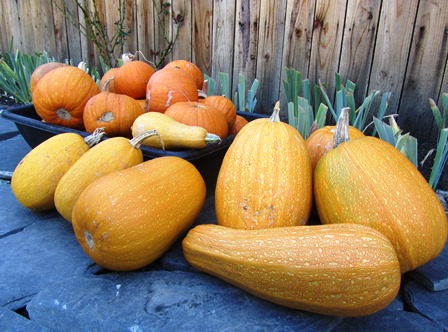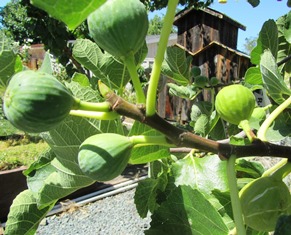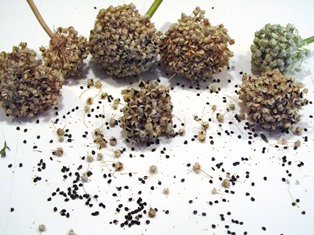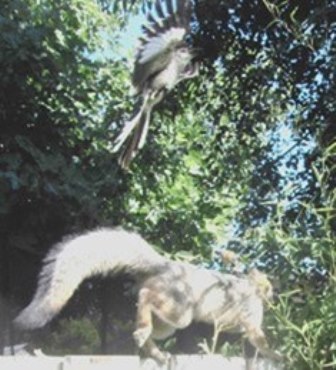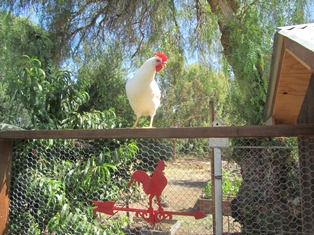Archive for August, 2014
Pumpkin and Squash–Dealing with Vine Sprawl
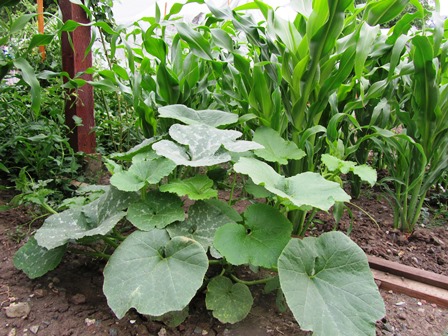
A squash plant will grow well in small gardens on supports such as a teepee of three poles tied together or on a fence
With the California drought looking like there’s no end in sight, I began pulling what I could from the garden. A lot of the space was taken up this year with squash and pumpkins. Vines are everywhere.
It’s my own fault for not keeping a better control over the direction of the vines. I could have grown them up and over a support, but I didn’t. Once ignored,the vines took over the whole garden, more than 25 to 30 feet in almost every direction.
I grew mainly heirloom varieties of squash and the French sugar pumpkins. One pumpkin plant reseeded from last year. Those vines climbed up into the five heirloom tomato plants, two apricot trees, and headed out toward the Lady Banks Rose and the Climbing Sally Holmes roses that border the garden. Inching even further, the squash vines moved out of the garden into the back yard.
No doubt about it, I’m going to have to pull on work gloves and a straw hat and get out there to dig out those dried vines and pull them out. Next year, trellises and supports for everything. Water is a commodity in crisis right now, at least in this state and everyone has to do their part. We’re just going to harvest the squash and pumpkins early and pray for early rains.
Travel Is a Gift that Keeps on Giving
Farmette life keeps me close to home these days, but lately I’ve been thinking about some of the places I’ve been in the world and it occurred to me that travel has inspired and, in many ways, transformed me. It also has broadened my horizons, shaped my worldview, and contributed immeasurably to my sense of well-being.

Ephesus, a few miles from Kusadasi, on Turkey’s turquoise coast, has spectacular ruins like this Greco-Roman library
The nice thing about travel is that it also can nurture your spirit and inform your writing. Since I’ve traveled a bit–something like 29 countries–mostly for pleasure and always on my own dime, I’ve met some wonderful people, tasted some great cuisine and wines, saw fantastic architecture, and learned colorful, cultural tidbits along the way.
Today as I was working on my Henny Penny Farmette mystery series, I thought about how I’d tasted the organic wines and fresh herbs of Greece, the chocolates of Belgium, honey in England, jams and tea in Ireland and Wales, spices of all kinds in India, wine and cheese in France, shortbread and butter cookies in Scotland, apple strudel all over Switzerland and Austria, and fine olive oil in Italy.
Travel for me is about food, people, and experiences during the journey. So often, in our world of bucket lists and destination travel, we miss the point of the journey. For me, it’s the life on the road that happens on the way to a destination that informs my writing and my worldview.
My first cozy mystery BEELINE TO MURDER draws upon farmette life and deals with beekeeping and honey and pastries, but also ties into the Caribbean. That book will be released October 2015.
My second book in the cozy mystery series focuses on herbs and has a tie-in to Haiti. That book comes out October 2016.
The third book involves the world of artisan chocolate. That book will be released October 2017. To write these books, I draw deeply from the well of experience and tap into my senses. Although the main focus of my novels is about solving a murder mystery, the stories always involve food and drink–a universal experience involving the senses.
For millennia, people have lived close to the earth, growing their own food, pressing their olives into oil, harvesting honey from their hives, and making their own wine. It’s how many of us choose to live today. That sense of connectedness–resonating across cultures, through centuries–informs my writing most of all.
Scented Geraniums
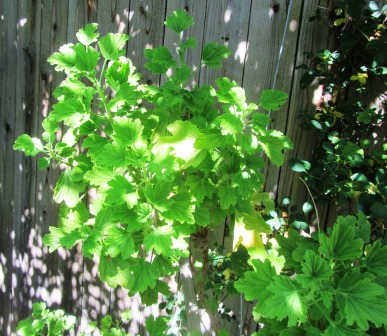
This lemon-scented Pelargonium crispum thrives in part shade and produces inch-wide, white-and-pink blooms
Brushing up against the leaves of a scented geranium releases fragrance to the area where they grow. It’s the main reason why these varieties are grown because those that bloom do not flower as colorfully or profusely as zonal geraniums.
They do, however, require the same care as zonals. They do best in well-drained, loose soil and this applies whether they are grown in pots or in the ground. They need water, but can tolerate some dry conditions.
Some scented geraniums grow from four-to-six feet tall with rounded leaves and range from a half inch to six inches (similar to oak leaves). Rubbing the leaves gently releases their potent and pleasing aroma.
Growing scented geraniums is easy and a delight to the senses. Why not try some in your garden? The following is a list of scented geraniums, suggestive of their diversity:
- Pelargonium crispum; lemon fragrance
- Pelargonium denticulatum; pine fragrance
- Pelargonium x fragrans; nutmeg fragrance
- Pelargonium graveolens; rose fragrance
- Pelargonium x nervosum; lime fragrance
- Pelargonium odoratissimum; apple fragrance
- Pelargonium scabrum; apricot fragrance
- Pelargonium tomentosum; peppermint fragrance
A 6.1 Quake Shakes Up the Napa Wine Country
Our neighbor (two houses down) called to say he wanted some of my Henny Penny Farmette honey and would be at the front door at 7:30 a.m.
I was out feeding the chickens, but after my husband gave me the message, I got a jar off the shelf and went to meet our neighbor. He asked me if I’d heard about the quake that had happened at 3:20 a.m., centered in American Canyon, about five miles southwest of Napa.
I hadn’t felt it, but his wife had. Napa is exactly 34 miles from our farmette and it was a fairly large quake at 6.1, according to seismologists. The 1989 Loma Prieta quake, by contrast, was a 7.0 quake on the San Andreas Fault, a major fault line.
The Loma Prieta Quake is the one I’ll never forget. At 5:04 p.m., it interrupted a Bay Area World Series game that my husband attended with a buddy. Candlestick Park went dark and San Francisco, because of broken gas lines, erupted in flames. My husband couldn’t get back home until 4:00 in the morning.
According to Dan Vergano, writing for National Geographic, the Napa Valley quake likely was caused by a series of cracks beneath the earth “tied to the famed and feared San Andreas Fault.
Vergano went on to say that some early reports suggested that the quake may have been provoked by the Franklin Fault that has been dormant for 1.6 million years. See http://news.nationalgeographic.com/news/2014/08/1400824-earthquakes-usgs-napa-california-faults-science/
The news reports videos on local television stations showed cracks through vineyards and across Highway 121 as well as wine bottles strewn on the floor at wineries. See, https://www.yahoo.com/travel/this-is-what-it-looks-like-when-an-earthquake-hits-wine-95640002407.html
The Napa airport control tower lost its windows. The Gold Rush-era buildings downtown are badly damaged, some in spite of earthquake retrofitting. The quake ran roughly 6.7 miles beneath Napa wine country (by contrast the Loma Prieta quake ran about 11 miles deep).
The cleanup is on; the community is pulling together as our Bay Area folks and first-responders always do in times of emergency or natural disaster.
The Figs Are Ripe, Fire Up the Grill
Last night the raccoons raided my fig trees, leaving a little deposit between honeybee apiary and the hen house. I know because this morning, I almost stepped in it . . . and I was barefoot and in still in my pajamas.
It was expecting the raccoons to drop by. It’s that time of the year when they like to show up for a little late night dining. Who can blame them. Figs ripened to perfection are among my favorite fresh foods, too.
Right now, the limbs of my Genoa White Fig hold an abundance of fruit covered in a thin green skin with rose-colored flesh. Whether you prefer to dry figs, make them into jam, use them in a tart, or serve them fresh with a little goat cheese, almost any variety of ripe fig will be delicious. They are an ancient food, dating back thousands of years to Asia Minor. The trees are hardy and can reach 12 to 20 feet tall.
The Brown Turkey, like the White Genoa, is self fertile and produces a multitude of delectable figs by its third year. The skin of Brown Turkey figs turns violet-brown with watermelon-colored flesh when fully ripe. Also, ripe figs turn downward from the limb–it’s how we they’re ready for picking.
I like to serve figs wrapped in Prosciutto, stuffed with a lovely, locally made goat cheese, and grilled. They make a great appetizer when friends drop by this time of year. The figs and goat cheese will pair nicely with a bottle of your favorite wine.
Since we live only about 25 to 30 minutes from the Napa wine country, we tend to buy local.
RECIPE: GRILLED FIGS, GOAT CHEESE, and PROSCIUTTO
Ingredients:
6 to 8 Brown Turkey or other ripe figs
1/3 cup goat cheese (or a bit more as needed; try herb goat cheese as a variation)
6-8 slices of Prosciutto
1/3 cup organic raw honey
Directions:
Fit a pastry bag with a tip to pipe the goat cheese.
Fill the bag with goat cheese.
Cut tiny openings into the bottom of each fig to permit insertion of the piping tip.
Pipe the filling into 8 to 10 figs (they’ll swell; don’t over fill or they’ll split).
Wrap slices of Prosciutto around each stuffed fig.
Brush the grill grate with olive oil.
Grill the figs 2 to 3 minutes.
Remove from heat, plate the figs, and drizzle honey across them.
Serves: 4 (2 figs per person)
A Drought Is No Way to Dry Onions
With water use restricted in many counties because of the terrible drought, my garden is withering. Everyone in the Bay Area has to do their part. My onions look particularly pathetic.
In July, I polished a mystery I had hoped to sell. Mid-month, BEELINE TO MURDER sold to Kensington Publishing in New York as the first in a three-book deal. That meant I had to get cracking on the second book.
I forgot the onions. Poor things. The tops fell over and wilted, the bottoms swelled and stopped. A few succumbed to the soil organisms and bugs.
August rolled around and I looked over the patch of brown stems and the heads that had gone to seed and vowed to dig everything out. But then . . . I got an offer to write a short nonfiction book that tied into the Law of Attraction, one of my favorite subjects. The onions had to wait for another 20 days until I cranked out that project.
Yesterday, my husband harvested the onions. Some have to be tossed because of bottom rot. Anything ignored will wither and die–that’s an axiom of gardening I’ve known since forever. So, the onions are gone, but their seeds are plentiful (thousands), so this fall I will plant a new crop of onions and another in the spring and pray for rain.
The Fox, the Fence, and an Angry Bird
The Henny Penny Farmette name was inspired by the English folktale featuring Chicken Little, Lucy Goosey, Foxy Loxey, and the gang. And now, it’s beginning to seem more like we’re living that folktale on our Henny Penny Farmette with the ongoing shenanigans of the foxes, wild birds, and chickens.
The foxes showed up mid-morning, no doubt to see if the chickens were out. The presence of humans frightened the four-legged gray foxes and the two of them leaped to the fence to make a quick-like-a-fox getaway.
Feeling thankful that I hadn’t yet released the chickens from the hen house, I grabbed the camera and took aim at the fox on the fence. I missed the first fox but just as I snapped the shot of the second fox on the run, a seemingly angry mockingbird dove down to thwart the fox from getting any closer to her nest . . . or for some other reason that remains obscure.
It’s night now and the chickens are all locked in the hen house on the roost. I hope the foxes stay away because when they come around the chickens raise such a ruckus, no one can get any sleep. And it’s been a very long day on the farmette that has followed a series of long days involving those wild foxes looking for a chicken dinner.
Drought Hurts Honeybees, Too
The star thistle blooms in yellow bursts of color over the brown, drought-parched hills of the Bay Area during summer. Widely considered a noxious, invasive weed, the yellow star thistle’s blooms serve as a source of food for the honeybees during drought conditions when flower sources become scant.
While naturalists, government officials, land management people, ranchers, gardeners, farmers, and road and park maintenance workers consider the yellow star thistle challenging to control, others lament indigenous plants suffer or die because the yellow star thistle depletes the soil of moisture. Its one redeeming value appears to be as a food source for the bees.
Local beekeepers understand the value of the yellow star thistle during severe drought when water rationing in many counties mean few if any flowers are left blooming in August and September. While the plant’s nectar is great for the bees, it’s bad news for horses. Feeding on yellow star thistle over time can cause a horse malady known as chewing disease.
Also called St. Barnaby’s thistle and yellow cockspur, the yellow star thistle’s long tap root keeps it going while other plants around it die from lack of water. In Europe where the plant is indigenous, it is held in check by other plants that have co-evolved with it and by herbivores, the enemies of yellow star thistle. However, that’s not the case in the United States.
Since it was introduced to America in the early part of the 20th Century, the yellow star thistle has spread faster than a California wildfire and now covers some 15 million acres, just in this state alone. It is also considered a noxious, invasive weed in 35 other states. But the honeybees don’t care as long as there are enough of those yellow blooms to get them through the dog days of summer.
They’re Ba-a-c-k!
The sound of the chickens squawking propelled me upright in bed. The sun wasn’t up yet but there was a ruckus going on in the chicken house. And it didn’t sound pretty.
I leaped from bed, staggered to the window, pulled up the blind, and looked out.
The foxes had returned. One stood on its hind legs, pawing at the double layer of poultry wire screwed over the open chicken window.
I yelled, “Get out of there!” hoping the fox would leave . . . but it didn’t. It just made the chickens squawk louder.
Throwing on my robe, I raced to the patio where my red, rubber (indestructible) clogs waited for my feet to slide in. Grabbing the broom and a two-by-four, I raced to the chicken house, yelling all the way.
This time the fox paid attention, but showed no interest in retreating. I waved the broom and pounded my board against the metal garbage can (in which I keep the 25-pound bags of chicken feed). The noise did the trick. Off went the fox to join the other two.
The three disappeared into the wooded acre of land behind our property. Finally, my chickens settled down. I let them out for the day. One deposited her egg–not in the nesting box–but on the ground, as if too freaked out to go back inside the hen house. Well, can you blame her?
Carlos Lays a Beautiful Stone Floor Despite Some Surprises
My daughter knew my husband Carlos had an opening in his schedule and wanted him to create a carefree stone floor for her backyard. She wasn’t interested in grass or plants, given the California drought, and her husband came up with a design. Easy.
But as it turns out, the design was fairly complicated. It consisted of a cross with a circular medallion. The stones were four different sizes and two different colors. Maybe not so easy.

Green string, tightly strung provides a guide for correctly positioning the stones in the circle and in straight lines
Carlos, nevertheless, rose to the occasion and with a buddy got to work. My daughter swore that all the sand and rock Carlos would need were already there from the previous patio, but that turned out not to be the case.
So imagine Carlos’s surprise when he realized he would have to pull out the dirt, level the ground, and do all that prep work before he could start laying stone.
Everyone put their stress aside, ordered sand and gravel, assemble the tools like the rake, mallet, and wheelbarrow, and enlisted one of our neighbors for additional help.
It took more than week. But the work is almost finished. My daughter loves the patio and she’s already planning a late summer party to show it off.
Carlos is thinking maybe we could use a floor like that on our farmette. With all the work we do, it’s nice to have a flat floor with a bench and table to sit a spell and catch your breath.
 Facebook
Facebook Goodreads
Goodreads LinkedIn
LinkedIn Meera Lester
Meera Lester Twitter
Twitter



